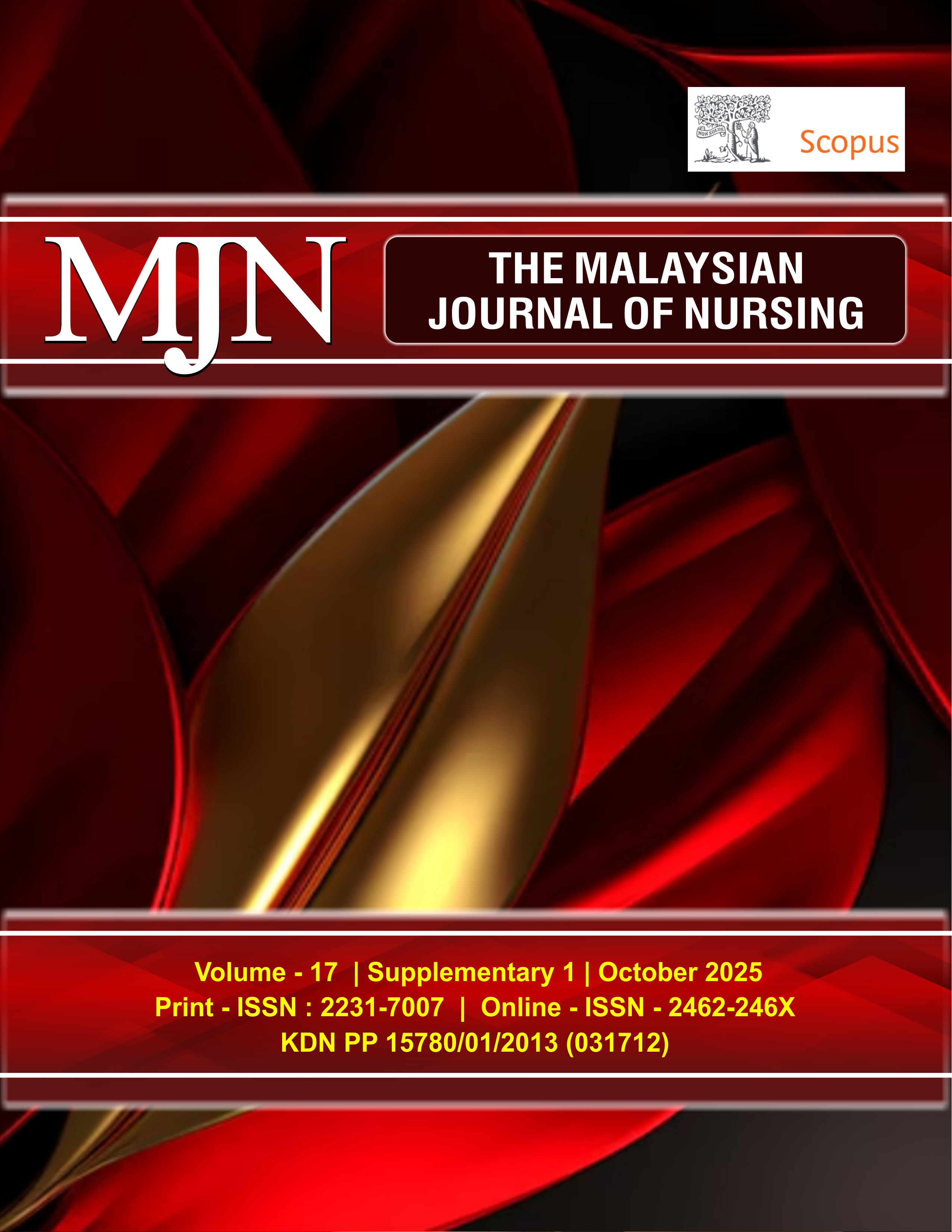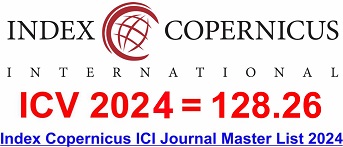Mental Health and Death Anxiety among Community- Dwelling Elderly: A Cross-Sectional Study
DOI:
https://doi.org/10.31674/mjn.2025.v17isupp1.013Abstract
Background: Elderly individuals, while representing a vital part of society, often experience psychological challenges associated with ageing. Among these, mental health problems and death anxiety are particularly significant, as they directly affect quality of life and social contribution. Identifying their psychological status and related factors is therefore essential to support the well-being of this vulnerable group. Objectives: This study aimed to assess the mental status and death anxiety level of elderly people in Najaf city and to find out the relationship between death anxiety and mental status with socio-demographic data among elderly people. Methods: A descriptive cross-sectional study was carried out from 15th October 2023 to 1st April 2024 on a sample of 200 community-dwelling elderly participants in Al-Najaf Al-Ashraf province. Results: Most of the study participants exhibited death anxiety and abnormal mental status, indicating possible cognitive impairment. A highly significant relationship was observed between mental status and age, marital status, and economic status (p < 0.01), whereas number of children and place of residence showed no significant effect. The study also found a non-significant correlation between mental status and death anxiety. Conclusion: The study concluded that most of the study samples had abnormal mental status, indicating possible cognitive impairment and the presence of death anxiety. Hence, the study recommends encouraging elderly people to do many simple daily activities to distract them from thinking about death and enhance their mental state, such as worship, reading, and housework.
Keywords:
Death Anxiety, Disorder, Elderly, Mental StatusDownloads
References
Adelirad, F., Sabahiazar, K., Asghari-Jafarabadi, M., Namjoo, S., Chattu, V. K., & Allahverdipour, H. (2021). Gender difference about death anxiety among older adults: Structural equation model. Psychogeriatrics, 21(3), 296–303. https://doi.org/10.1111/psyg.12663
Afrashteh, M. Y., Majzoobi, M. R., Janjani, P., & Forstmeier, S. (2024). The relationship between the meaning of life, psychological well-being, self-care, and social capital, with depression and death anxiety in the elderly living in nursing homes: The mediating role of loneliness. Heliyon, 10(9). https://doi.org/10.1016/j.heliyon.2024.e30124
Alagiakrishnan, K., Zhao, N., Mereu, L., Senior, P., & Senthilselvan, A. (2013). Montreal cognitive assessment is superior to standardized mini-mental status exam in detecting mild cognitive impairment in middle-aged and elderly patients with type 2 diabetes mellitus. BioMed Research International, 2013, 186106. https://doi.org/10.1155/2013/186106
Assari, S., & Lankarani, M. M. (2016). Race and gender differences in correlates of death anxiety among elderly in the United States. Iranian Journal of Psychiatry and Behavioral Sciences, 10(2), e2024. https://doi.org/10.17795/ijpbs-2024
Bakan, A. B., Arli, S. K., & Yıldız, M. (2019). Relationship between religious orientation and death anxiety in elderly individuals. Journal of Religion and Health, 58(6), 2241–2250. https://doi.org/10.1007/s10943-019-00917-4
Ebrahimi, B., Hosseini, M., & Rashedi, V. (2018). The relationship between social support and death anxiety among the elderly. Elderly Health Journal, 4(2), 37–42. https://doi.org/10.18502/ehj.v4i2.261
Ghasemi, F., Atarodi, A., & Hosseini, S. S. (2020). The relationship between religious attitudes and death anxiety in the elderly people. Journal of Research and Health, 10(3), 135–142. http://jrh.gmu.ac.ir/article-1-1768-en.html
Gürbüz, A., & Yorulmaz, O. (2024). Death anxiety in psychopathology: A systematic review. Psikiyatride Güncel Yaklaşımlar, 16(1), 159–174. https://doi.org/10.18863/pgy.1267748
Hajihasani, M., & Naderi, N. (2021). Death anxiety in the elderly: The role of spiritual health and perceived social support. Aging Psychology, 6(4), 309–319. https://doi.org/10.22126/jap.2020.5778.1473
Hong, Y., Yuhan, L., Youhui, G., Zhanying, W., Shili, Z., Xiaoting, H., & Wenhua, Y. (2022). Death anxiety among advanced cancer patients: A cross-sectional survey. Supportive Care in Cancer, 30, 1–9. https://doi.org/10.1007/s00520-022-06795-z
İnci, F., & Sözen, K. K. (2024). Examining nurses’ death anxiety and attitudes toward caring for dying patients: A cross-sectional study in Turkey. Psychology, Health & Medicine, 29(8), 1437–1447. https://doi.org/10.1080/13548506.2024.2336892
Jazaiery, M., Rezaeifar, K., Sayyah, M., & Cheraghi, M. (2022). Relationship between mental health and death anxiety during COVID-19 pandemic in dental staff and students: A cross-sectional study. Frontiers in Psychiatry, 13, 849868. https://doi.org/10.3389/fpsyt.2022.849868
Jemal, K., Geleta, T. A., Deriba, B. S., & Awol, M. (2021). Anxiety and depression symptoms in older adults during coronavirus disease 2019 pandemic: A community-based cross-sectional study. SAGE Open Medicine, 9, 20503121211040050. https://doi.org/10.1177/20503121211040050
Karaman, S., Bahçecioğlu Turan, G., Çayır Yılmaz, M., & Yilmaz Karabulutlu, E. (2025). Examination of elder abuse and death anxiety in older adults with a chronic disease. Nursing Open, 12(1), e70092. https://doi.org/10.1002/nop2.70092
Kurlowicz, L., & Wallace, M. (1999). The Mini-Mental State Examination (MMSE). Journal of Gerontological Nursing, 25(5), 8–9. https://doi.org/10.3928/0098-9134-19990501-08
Li, H., Jia, J., & Yang, Z. (2018). Mini-mental state examination in elderly Chinese: A population-based normative study. Journal of Alzheimer’s Disease, 53(2), 487–496. https://doi.org/10.3233/JAD-160119
Lu, J., Yang, Y., & Ma, H. (2025). A network meta-analysis of different psychological therapies for death anxiety in older adults. OMEGA - Journal of Death and Dying, 0(0). https://doi.org/10.1177/00302228251316924
Mohammadpour, A., Sadeghmoghadam, L., Shareinia, H., Jahani, S., & Amiri, F. (2018). Investigating the role of perception of aging and associated factors in death anxiety among the elderly. Clinical Interventions in Aging, 13, 405–410. https://doi.org/10.2147/CIA.S150697
Taghiabadi, M., Kavosi, A., Mirhafez, S. R., Keshvari, M., & Mehrabi, T. (2017). The association between death anxiety with spiritual experiences and life satisfaction in elderly people. Electronic Physician, 9(3), 3980–3987. https://doi.org/10.19082/3980
Templer, D. I. (1970). The construction and validation of a Death Anxiety Scale. Journal of General Psychology, 82(2d Half), 165–177. https://doi.org/10.1080/00221309.1970.9920634
Turan, G. B., & Dural, G. (2025). Does spiritual well-being affect death anxiety and psychological resilience in cancer patients? OMEGA—Journal of Death and Dying, 90(4), 1909–1924. https://doi.org/10.1177/00302228221129948
Yang, L., Yan, J., Jin, X., Jin, Y., Yu, W., Xu, S., ... & Liu, C. (2018). Estimation of diagnostic performance of dementia screening tests: Mini-Mental State Examination, Mini-Cog, Clock Drawing Test, and Ascertain Dementia 8 Questionnaire. Aging & Mental Health, 22(8), 948–952. https://doi.org/10.1080/13607863.2017.132070
Zan, H. M., Adea, M. K., & Abd Ali, D. K. (2018). Research determination of dementia among nursing homes residents. Research Journal of Pharmacy and Technology, 11(10), 4439–4442. https://doi.org/10.5958/0974-360X.2018.00812.0
Zhang, D., Zheng, W., & Li, K. (2024). The relationship between marital status and cognitive impairment in Chinese older adults: The multiple mediating effects of social support and depression. BMC Geriatrics, 24, 367. https://doi.org/10.1186/s12877-024-04975-6
Zhang, Y., Su, D., Chen, Y., Tan, M., & Chen, X. (2022). Effect of socioeconomic status on the physical and mental health of the elderly: The mediating effect of social participation. BMC Public Health, 22, 605. https://doi.org/10.1186/s12889-022-13062-7
Zhou, J., Wu, B., Su, L., & Ma, X. (2024). The influence of Tai Chi on the death anxiety of elderly people living alone: The chain mediating effect of social support and psychological capital. Frontiers in Psychology, 14, 1303524. https://doi.org/10.3389/fpsyg.2023.1303524
Published
How to Cite
Issue
Section
License
Copyright (c) 2025 The Malaysian Journal of Nursing (MJN)

This work is licensed under a Creative Commons Attribution-NonCommercial-NoDerivatives 4.0 International License.



































